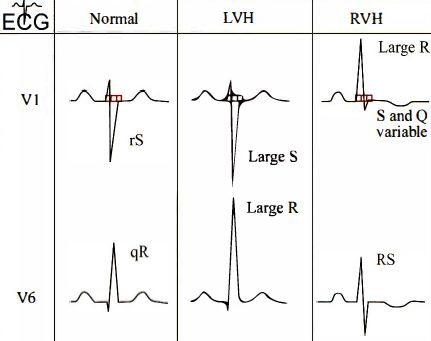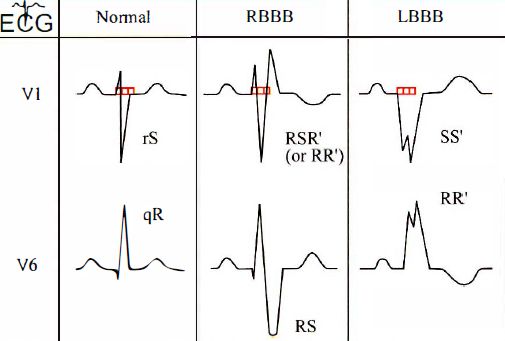Difference between revisions of "ECG-ALGORITHM"
(Imported from text file) |
(Imported from text file) |
||
| Line 1: | Line 1: | ||
===== [[Summary Article|'''SUMMARY''']] ===== | ===== [[Summary Article|'''SUMMARY''']] ===== | ||
<i>RATE</i> | <i>RATE</i> | ||
<br/>1. ASSESS RATE: 300/(large squares) interval in mm. Bradycardia if HR | <br/>1. ASSESS RATE: 300/(large squares) interval in mm. Bradycardia if HR < 60/min; tachycardia if HR > 100/min. | ||
<br/> | <br/> | ||
<br/><i>RYTHM</i> | <br/><i>RYTHM</i> | ||
<br/> | <br/> | ||
<br/>2. ASSESS RYTHM: RR intervals (1 small square variation is normal) & check that a P precedes a QRS complex. | <br/>2. ASSESS RYTHM: RR intervals (1 small square variation is normal) & check that a P precedes a QRS complex. | ||
<br/> | <br/> | ||
<br/><i>INTERVALS</i> | <br/><i>INTERVALS</i> | ||
<br/>3. EXAMINE PR INTERVAL: normal 120-200ms, prolonged if heart block present. | <br/>3. EXAMINE PR INTERVAL: normal 120-200ms, prolonged if heart block present. | ||
<br/> | <br/> | ||
<br/>4. EXAMINE QRS INTERVAL: normal | <br/>4. EXAMINE QRS INTERVAL: normal < 100ms. Prolonged in BBB, WPW, ventricular pacemaker, tricyclics. | ||
<br/> | <br/> | ||
<br/>5. EXAMINE QT INTERVAL: 340-470 ms. Prolonged in tricyclic overdose, hypo-Ca/Mg/K, starvation, hypothermia, quinidine, sotalol, amiodarone use. | <br/>5. EXAMINE QT INTERVAL: 340-470 ms. Prolonged in tricyclic overdose, hypo-Ca/Mg/K, starvation, hypothermia, quinidine, sotalol, amiodarone use. | ||
<br/> | <br/> | ||
<br/><i>WAVEFORMS</i> | <br/><i>WAVEFORMS</i> | ||
<br/>6. INTERPRET WAVEFORM. | <br/>6. INTERPRET WAVEFORM. | ||
<br/> | <br/> | ||
<br/>7. ASSESS ST-SEGMENT: elevated in ACS, pericarditis, Prinzmetal angina and others. | <br/>7. ASSESS ST-SEGMENT: elevated in ACS, pericarditis, Prinzmetal angina and others. | ||
<br/> | <br/> | ||
<br/><i>OTHERS</i> | <br/><i>OTHERS</i> | ||
<br/>8. ASSESS AXIS: Normal is -30 to +100. +I +aVF: normal; -I +aVF: RAD; +I -aVF: LAD; -I -aVF: RAD/LAD. LAD is a marker for CAD, RAD is normal for children, young adults; RVH in older adults. | <br/>8. ASSESS AXIS: Normal is -30 to +100. +I +aVF: normal; -I +aVF: RAD; +I -aVF: LAD; -I -aVF: RAD/LAD. LAD is a marker for CAD, RAD is normal for children, young adults; RVH in older adults. | ||
<br/> | <br/> | ||
<br/>9. ASSESS HYPERTROPHY: | <br/>9. ASSESS HYPERTROPHY: | ||
<br/>[[Image:paste-37711181b9927f4c0aeecd6996699393167c7721.jpg]] | <br/>[[Image:paste-37711181b9927f4c0aeecd6996699393167c7721.jpg]] | ||
<br/> | <br/> | ||
<br/>10. ASSESS BRANCH BLOCK: LBBB (QRS 120-180 ms), RBBB (QRS | <br/>10. ASSESS BRANCH BLOCK: LBBB (QRS 120-180 ms), RBBB (QRS > 120 ms) | ||
<br/>[[Image:paste-b85645b70154480c5df1ba6fe935c0cd1363d585.jpg]] | <br/>[[Image:paste-b85645b70154480c5df1ba6fe935c0cd1363d585.jpg]] | ||
[[Category:Electrocardiogram]] | [[Category:Electrocardiogram]] | ||
[[Category:Advanced Life Support]] | [[Category:Advanced Life Support]] | ||
Latest revision as of 11:31, 1 January 2023
SUMMARY
RATE
1. ASSESS RATE: 300/(large squares) interval in mm. Bradycardia if HR < 60/min; tachycardia if HR > 100/min.
RYTHM
2. ASSESS RYTHM: RR intervals (1 small square variation is normal) & check that a P precedes a QRS complex.
INTERVALS
3. EXAMINE PR INTERVAL: normal 120-200ms, prolonged if heart block present.
4. EXAMINE QRS INTERVAL: normal < 100ms. Prolonged in BBB, WPW, ventricular pacemaker, tricyclics.
5. EXAMINE QT INTERVAL: 340-470 ms. Prolonged in tricyclic overdose, hypo-Ca/Mg/K, starvation, hypothermia, quinidine, sotalol, amiodarone use.
WAVEFORMS
6. INTERPRET WAVEFORM.
7. ASSESS ST-SEGMENT: elevated in ACS, pericarditis, Prinzmetal angina and others.
OTHERS
8. ASSESS AXIS: Normal is -30 to +100. +I +aVF: normal; -I +aVF: RAD; +I -aVF: LAD; -I -aVF: RAD/LAD. LAD is a marker for CAD, RAD is normal for children, young adults; RVH in older adults.
9. ASSESS HYPERTROPHY:

10. ASSESS BRANCH BLOCK: LBBB (QRS 120-180 ms), RBBB (QRS > 120 ms)
